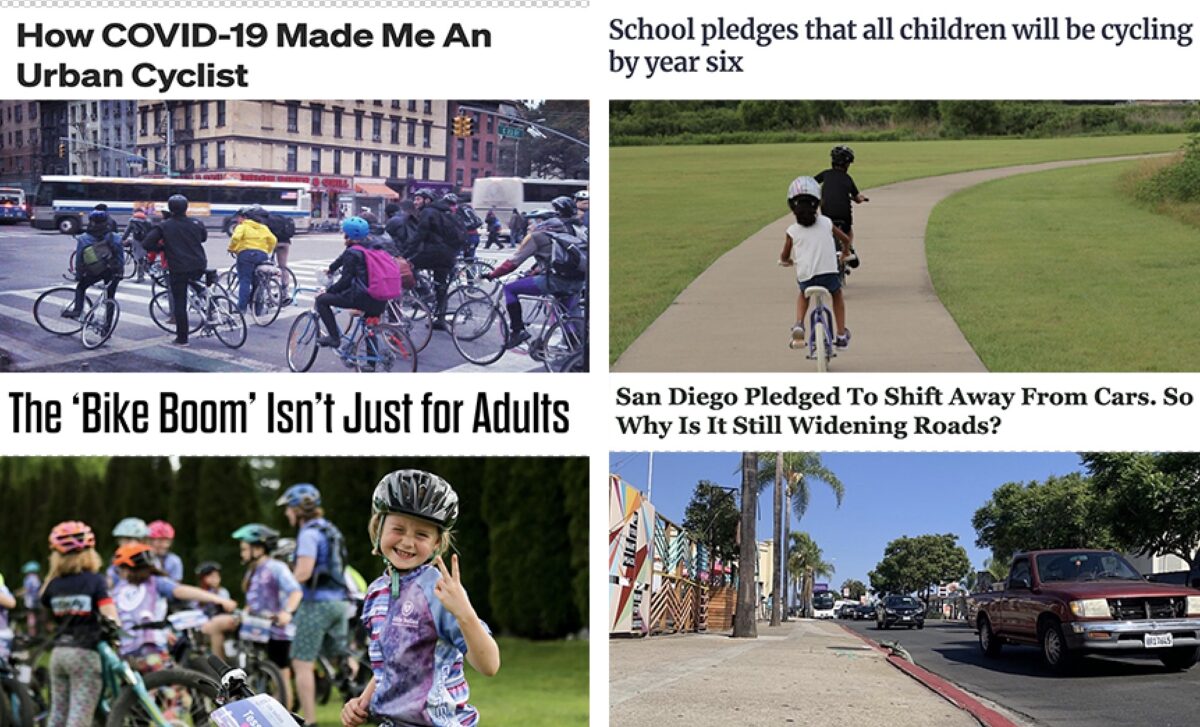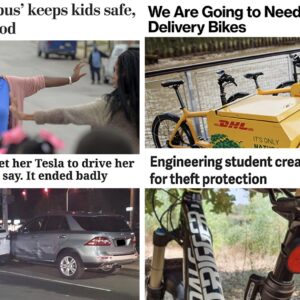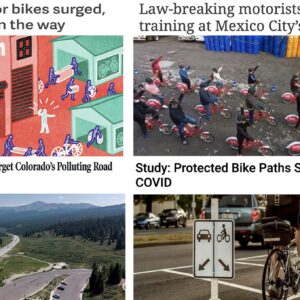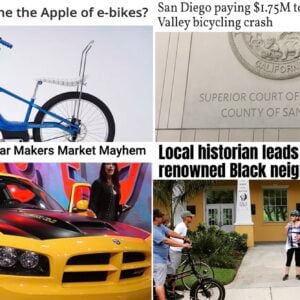Welcome to the week. This feels like the week where we finally leave summer behind. I don’t want to jinx it or anything, but it sure would be nice to have some cooler temps and rain.
Before we get into the meat of another week, let’s get you caught up with most notable items found by BikePortland editors and readers in the past seven days…
DOTs gonna’ DOT: A neighborhood in Virginia is rising up against a car-centric highway widening proposal that the DOT falsely claims will improve safety by adding more lanes, and a recent protest included a march alongside a casket to make their points.
Pedaling and predictability: Covid enticed a New York City journalist to become an everyday bike rider and he found an unexpected benefit of cycling: always knowing exactly when he’ll arrive.
Distraction, Inc.: Because massive monster trucks, hot-rodding racecars, and record amounts of traffic deaths weren’t enough, this piece in Slate details how massive “infotainment” screens are the latest example of how the unhinged auto industry continues to lead with greed at any cost.
Echoes of Hawthorne: Ugh. “Salt Lake City’s transportation director said this project doesn’t need bike lanes because there are already options on neighboring streets.” We shudder to think that Portland’s decision to do the same thing on Hawthorne Blvd is influencing other city transportation staffers to make similarly silly decisions.
Park and bike: A school leader in the U.K. wants every student to learn to ride a bike and has introduced a “park and stride” program to encourage even families who typically drive all the way to school to park the car and take bikes for the final leg of their journey.
Advertisement
Old projects, new risks: This story about an old road-widening project in San Diego that might be built despite current opposition, reminds me that it would be smart to have some sort of re-assessment clause in all project planning that allowed leaders and planners to make changes based on factors like community desires, public health, climate change, and so on.
No more local match: A new law in Illinois says that local governments no longer have to cough up a big chunk of cash to unlock state transportation infrastructure funding.
Youth bike boom!: National nonprofit People For Bikes reports a very sizable increase in the number of kids riding bikes thanks to the pandemic. Now that’s a silver lining.
The other big EV-car problem: Car charging infrastructure is an often glossed-over aspect of dreamy EV-car visions, which makes this piece from Aaron Gordon such a must-read.
Cleaner trucks in Oregon: Program director for Oregon Environmental Council says in an op-ed that our state needs stronger regulation to encourage cleaner trucks, vans and buses — which account for 25% of transportation GHG emissions despite making up just 10% of the vehicle fleet.
Slow speeds for thee but not for me: Funny how when BMW makes a play in the bicycle market they create a vehicle that comes with high tech speed-limiters on-board, but they have yet to do that with their cars.
Thanks to everyone who shared links this week!
— Jonathan Maus: (503) 706-8804, @jonathan_maus on Twitter and jonathan@bikeportland.org
— Get our headlines delivered to your inbox.
— Support this independent community media outlet with a one-time contribution or monthly subscription.








Thanks for reading.
BikePortland has served this community with independent community journalism since 2005. We rely on subscriptions from readers like you to survive. Your financial support is vital in keeping this valuable resource alive and well.
Please subscribe today to strengthen and expand our work.
With regards to the Salt Lake story, I disagree. That street (100 S) is in a rather unique position: it is one of only two streets that allow car access the University of Utah. It’s currently under construction with one lane out of two in each direction closed, and is a traffic nightmare during commute hours now. Ambulances are getting stuck in traffic there.
Meanwhile, the street literally one block to the south (200 S), the street two blocks to the south (300 S), and the street 2.5 blocks to the north (3rd Ave) are great bike streets to take to the University’s campus; in fact, it is the bike-friendly 200 S that has the restaurants and such in the area, while the hostile 100 S has no businesses of note. In addition, 200 S and 300 S are more direct routes to the University from the vast majority of the city for bikes; it is drivers that have to go a block out of their way to the north.
The current situation there is just fine; there is no need for bike lanes on 100 S. The extreme grid system in the area means it’s easy for anyone to get to 200 S, 300 S, or 3rd Ave from pretty much anywhere; nothing is lost by not having bike lanes on 100 S. In fact, 300 S is one of the best bike streets in the entire nation (way better than any street in Portland), with a long stretch of fully-protected bike lanes, protected intersections, and low speed limits.
Road diet with bike lanes and one motor vehicle lane each way. Center turn lane for emergency vehicles. Every street should be safe for cyclists. Especially with the immense platting of SLC blocks. There might not be many retail businesses on 100 S between 900 E and University st. but there are plenty of high density residential units. These residents deserve safe access to bicycle infrastructure. “Just” a block or two over is 1/4 to 1/2 a mile out of the way.
That’s a massive misstatement. A block over is not ½ to ¼ mile out of the way. it’s 660 ft, exactly ⅛ of a mile. And anyone who uses 100 S, except for those who live on it, is heading to the University or to the foothills trail system, there’s absolutely nowhere else that 100 S goes in that direction. Anyone who lives on 100 S itself can easily still use 200 S, considering that the north/south 1000 E, 1100 E, 1200 E, and University St in the area are all just fine for bikes. The grid system really is wonderful and allows for stuff like this.
Now, I would absolutely support a road diet in your suggested configuration on South Temple (the street one block north of 100 S) in this area. That street does not need two car lanes in each direction east of 700 E. In that case, the streets one block north (S Temple) and one block south (200 S) would be very adequate for anyone who lives on 100 S to get anywhere.
1/8 one way. Then 1/8 back is 1/4. If you live on a street and then need to leave it, you need to come back too. And going two 1/8 mile blocks out of your way to the “world class” 300 S from 100 S and back is 1/2 of a mile.
Except you don’t have to come back to it. The only way you would is if you had to go exactly due west (since due east is only the University). Otherwise you’d have to go north or south anyways. And the road dead-ends not too far to the west as well, meaning you’d need to go north or south no matter what to get around that. The only time it would be an issue is the very rare case when someone is starting at a residence on 100 S, and ending farther west, but not too far west, on 100 S (where there are few destinations).
Fair, you definitely know the area better. I just know if I live on a street, I much prefer to actually access things on that street directly. So if I lived on say 100 S and S 300 E, and wanted to take my kid to Reservoir Park or Salt Lake Regional Medial Center, I’d be annoyed I couldn’t just go down 100 S. Dropping down to 200 S then backup would add 27% (1.1 vs 1.4 miles) to the MC trip or 25% (1.6 vs 2.0) to the park trip. Are these edge cases? I don’t know, they seem pretty normal trips to me.
Whenever I hear things like, there’s a road for bikes a few blocks over, it just gets on my nerves. Every new street treatment should, in my opinion, try to promote walking/cycling/public transit. Re-doing Temple might be a good way to make trips like this a bit more easy, but 100 S is being redone and by law should have bike facilities added. Voting to expect it seems like the wrong approach.
No one ever seems to talk about this, but it’s not just your personal preference; Directness is one of the key principles of Dutch cycling infrastructure. It’s literally one of the fundamental reasons their mode share is so high, and why their society is so happy, healthy, and wealthy as a result: https://www.dutchcycling.nl/en/news/blog/5-design-principles-for-successful-bicycle-infrastructure
Also see: https://www.amazon.com/Building-Cycling-City-Blueprint-Vitality/dp/1610918797/ref=asc_df_1610918797/
(IIRC, these principles are talked about at length in the Portland 2030 Bike Plan, but of course no one at PBOT [with any decisionmaking power] has read it or cares about following it).
The aggregate social utility of switching from subway use to bike riding is likely to be low and, possibly, negative. The fact that this kind of thing is celebrated here is an example of why I find “urbanism” to not only be epistemologically deficient but also kind of cultish. (I have far sharper political differences with “urbanism” but this is off topic, so don’t tempt me.)
_ _ _ _ _ _ _ _ _ _ _ _ _ _ _ _ _ _ _ _ _ _ _ _ _ _ _ _ _ _ _ _ _ _ _ _ _
_ _ _ _ _ _ _ _ _ _ _ _ _ _ _ _ _ _ _ _ _ _ _ _ _ _ _ _ _ _ _ _ _ _ _ _ _
This comparison is misleading.
* The main justification for not budgeting in bike lanes on Hawthorne was a desire by the city to atone for its history of racism/classism by allocating more funds to historically neglected areas that have the least and worst transportation infrastructure.
How could it possibly be negative? How in the world does someone biking instead of taking the subway create negative utils?
That’s what they came up with when the ‘there are already better options” tactic didn’t find traction. PBOT is using the concept of equity concerns as a sword to kill projects they don’t want to do. In fact, if I remember correctly, the original justification was that PBOT believes bicycles are worse for the environment than SOVs, then came the just take another street justification. Then finally ‘equity’
And I’m saying that as someone who is completely indifferent to gutter lanes on Hawthorne.
There has been a staggering decline in subway usage in NYC so celebrating the apparent loss of a dedicated subway user is, at the very least, in poor taste.
At the very worst, subway usage will not recover and there is a possibility that the market urbanist “just ride bikes” narrative could be used to justify a decrease in funding for subways (e.g. a form of urban public transportation that is supposed to be accessible to every person, including those who cannot ride bikes for transportation).
_ _ _ _ _ _ _ _ _ _ _ _ _ _ _ _ _ _ _ _ _ _ _ _
https://www.portland.gov/sites/default/files/2020-08/hawthorne-pave-and-paint-evaluation-report.pdf
I applaud PBOT for centering anti-racism and anti-classism, for once.
Celebrating the loss of a dedicated subway user? What? You said it was a wash or even had the potential to create negative utils. How so? I know you generally don’t like bikes or bike infrastructure, or people riding bikes, but I’m just curious what the negative externalities of this person riding a bike instead of using the subway is. You really think a slight increase in biking is going to make the subway lose money? Have you ever ridden the NYC subway system? It’s extremely crowded. I really don’t think they are at risk for defunding due to lack of use.
Aww, I did forget, they claimed that it was both bad for the environment and bad for equity at the same time. Usually the DOTs like to go with one lie at a time, but they threw the kitchen sink at this one.
PBOT will continue to use equity to justify whatever it is they want to do as long as folks like you continue to eat it up. Remember when PBOT was claiming the Safe Streets signs couldn’t be done because it was inequitable. Hell, they are even pushing the i5 expansion by saying it’s a equity issue.
Like I said, I’m indifferent to the project because gutter lanes don’t increase biking, but to pretend that building bike lanes on Hawthorne is racist or classist is total nonsense and contributing to the toxic culture that keeps the CoP in gridlock and fails low income communities in the city.
Shockingly, the equitable solution is always going to be whatever ODOT or PBOT wanted to do in the first place. Weird.
I view bikes as being no more interesting than a sock, pan, or vacuum cleaner.
I use bike infrastructure just about every day and I definitely like the fact that it’s there but also want there to be a lot more of it in neighborhoods that have been historically neglected.
I’m neutral on people riding bikes as individuals but have always been a fan of increasing the number of people rolling at the expense of cage use. In fact, my interests in cycling advocacy has always been about getting people to drive less (less ecocide, less carnage, less tail-pipe-toxins).
If you think gutter lanes on Hawthorne come at the expense of infrastructure in east Portland, you’re just buying the lies PBOT are selling.
There are several layers of middle-management bloat, committees to study the efficacy of committees, and useless motorist projects that actually take money that could be used to make east Portland safer. Having east Portland be dangerous is a policy choice from ODOT and PBOT, not a lack of money. Don’t buy into their lies.
Funding for transportation equity in Portland has always been a zero sum game. We need decades of affirmative action to right this historic wrong.
Were the bike lanes adding appreciably to the hawthorn repaving budget? I get the justification that the area around hawthorn has, relatively speaking, more bike infrastructure than other and underserved areas. But it was my understanding that the repair and repaving of the road-base was the vast majority of the the cost. Re-striping in various configurations would not have changed the budget appreciably, right? Genuinely curious.
In other words, does PBOT have allocated bike lane only budget, would striping bike lanes vs the adopted configuration eaten into that budget, and where are those bike lane dollars going if they were saved?
There is little question that adding even the usual poor-quality PDX protected bike lanes from 12th to 50th (the ask of “healthier hawthorne”) would have been very expensive.
Got a citation for that? Cause PBOT seems to think changing the layout of Willamette during repaving isn’t very expensive. I don’t understand why Hawthorne would be any different and none of their documents for the alternatives did a cost comparison between their plans.
https://www.portlandoregon.gov/transportation/article/661190
* You are comparing a conventional bike lane with a protected bike lane.
* There are many concrete bulb outs and intersections on Hawthorne that would have required real money to make reasonably safe for a protected bike lane (e.g. not expose the city to even more legal risk).
FWIW, a cheaper painted bike lane was possible and, even, worth doing (esp if cheap but effective improvements to adjacent NGs were part of the package) but there was hostility towards this compromise from some (many) protected bike lane proponents. And, unfortunately, even a striped bike lane would have likely required extra money to address existing concrete.
So no citation. I agree it could be more expensive but there’s literally no evidence for your claim that Alternative 3 would have been very expensive.
I’d also say the lack of consideration of the cost for a plan that PBOT was actively trying to make look bad is pretty compelling that any such a claim doesn’t have a leg to stand on.
Legal risk? PBOT didn’t let a real doozy of a bulb out at the intersection of Rosa Parks and Vancouver stop them from putting a protected bike lane in on Rosa Parks. A couple of years in, that intersection still scares the crud out of me every time I approach it. If PBOT didn’t think that intersection was too dangerous, I can’t imagine there’s anything on Hawthorne that’s worse. And further down, the intersection between Rosa Parks and Willamette is also treacherous. I’d say 60%+ of the cars that go westbound through that intersection have two wheels fully in the bike lane.
Oh yeah, and didn’t the Rosa Parks PBL go in as an opportunistic project that piggybacked on a repaving project with minimal public input? I think it did if memory serves me correctly. And I must say, the project was pretty darn successful, all in all. There were a lot of teething problems along the way. It’s still not the best bike way in the world. And it’s underutilized. But it works.
Hawthorne is a <20 mph business district with very heavy pedestrian density, heavy SOV traffic (IMO it would be better for everyone if this were eliminated), and a veritable forest of bulb outs and driveways. From the perspective of engineering one of PBOT's crappy protected bike lanes, it's nothing like Rosa Parks.
Oh, so we’re talking about different things. I was talking about the “pave and paint” Hawthorn project between 24th and 50th. The choice given there, and I believe an option bike activists are asking for in SLC, was between a number of different paint orientations, one had bike lanes. Choosing the paint orientation they did (option 2 vs 3a or 3b), didn’t as far as I know decrease the cost of the hawthorn 24th to 50th project.
I really respect your previously stated equity stance vis-a-vis prioritizing public transportation, even in some instances to the detriment of cycling infrastructure. I think that position has its merits. But I think you make your strongest arguments when the facts aren’t mischaracterized or the framing isn’t distorted.
I’d push back on simple parking protected bike lanes being “very expensive”. In comparison to what, the cost of redoing the roadway? Surely not. In comparison to do nothing? assuredly. But the fact remains that PBOT was going to need to repave the street. I guess you could argue that they didn’t explicitly need to do it, but you’d be hard pressed to find many people arguing that we should let an important and expensive piece of infrastructure fall into an even more expensive state of disrepair. So, if it was going to be ripped up and redone, why not move that parking over and put in protected lanes? Would it slow buses down? If so, that’s a great argument against it and one you might have me on board for. But to say it’s more expensive, in any real appreciable percentage of the total budget is not believable, at least to me.
That’s my basic position. IMO, addressing transportation inequity has more utility than the cost of letting infra in wealthier neighborhoods fall into disrepair. I also realize that in the real world this will never happen so the final version of the Hawthorne Pave & Paint project did seem like a messy lesser evil to me.
This is fair and I regret my use of “very expensive” instead of “more expensive”.
The BMW story reminds me of the cobble stone strips to limit bike speeds on the bike path parallel to the Autobahn. Despite having no speed limits on the autobahn and cobble stones on their bike paths, Germany has good bike infrastructure and generally courteous drivers.
Regarding the “The other big EV-car problem” story, the solution is actually even simpler than the author recommends. I drive an electric car and have a level 2 charger in the garage but, because I have too much junk like a good American, I don’t park it in there often. Instead, I found myself using the outside level 1 charger most of the time. That’s plugged into a standard outlet and charges at 8A. I can charge at 12A but because I have to change the setting and I’m also lazy, I don’t so the car charges at only 8A. The point is that even that is enough to get me through the week. I may not be setting out with a full charge in the morning but it doesn’t matter because I never run out. I thought I would have to top up on the level 2 charger from time to time but that hasn’t actually happened.
I find that other EV owners also don’t plug in every night. Why? Because they don’t need to. This means that their L2 chargers are already overkill for the driving they do.
Turns out that just having standard outlets for people to plug in their $100 level 1 chargers would be sufficient. This kind of use would also promote off peak charging further benefiting the grid.
It’s also worth noting that slow “trickle charging” is better for battery life. Slowly charging your car overnight vs. using high-powered quick charge stations will extend your battery life. Battery management, and battery replacement costs (both in dollars and CO2) are going to become a big issue when more people transition to electric.
L2 and L1 are both slow charging systems and I’ve never seen any evidence that one is better for battery longevity than the other. Limiting charging to 80%, limiting discharge to 20%, reducing temperature extremes, and making L3 charging an occasional thing has a greater role in preserving SOC, AFAICT.
As someone who owns a 2012 leaf (with arguably the worst EV battery ever mass produced) I think concerns about battery longevity are overblown.
Completely agree about battery longevity, as the owner of a ’15 Leaf. Still charges to 100% at 66k miles despite being parked outdoors for several years in MN’s extreme climate.
I also agree that there isn’t probably much difference between L1 and L2 in battery longevity. I use a L2 charger “daily,” with our EVSE inside the garage but the cord snaked outside where the car is parked. We don’t really need to charge it daily, but there are times when we have been doing suburban errands on weekends, draining the battery to 20%, and would like the car to be fully charged the next day, which L1 will not necessarily do.
L3 is what really hurts battery longevity: ours does not have this capability, and I’m finding it’s common for people who never or rarely “fast-charge” to have similar battery outcomes as we do; and those who have L3 capability and use it more than infrequently are finding their capacity dropping a few percent by the time their car hits the age of ours.
I agree with Soren here. Both L1 & L2 charging rates are quite low. Keep in mind that electric vehicles routinely zap their batteries with massive charge when applying regenerative brakes. L1 & L2 charging rates are peanuts compared to regenerative braking.
You can compare battery longevity per make, model and year here.
https://www.geotab.com/fleet-management-solutions/ev-battery-degradation-tool/
I rent and I don’t have access to either a L1 or L2 socket on the outside of my apartment building (and the inside sockets are not grounded so a jerry rigged 90 foot extension cord charging set up would not work). In fact, lack of access to at-home charging is one of the things that makes EV ownership a largely upper class thing.
PS: As a renter, charging my 2012 EV* is an incredibly annoying and stressful affair that is only possible because I exclusively rely on my EV to replace the cage trips of my partner and friends (who do not or cannot use alternative modes).
*purchased for a pittance because no one wanted to purchase used leased leafs in 2014 and because I was worried that the leaf was going to be the next GM EV1 (which would have been a climate crisis disaster).
Apartments sometimes have covered parking spaces. Because these are typically lit at night, they have outlets on them. I believe this is per code but could be wrong. It would be entirely feasible to L1 charge off these without an extension cord provided that the charger could be secured somehow.
Multifamily housing can have outside outlets but in many cases the landlord/property management limit access and/or refuse to allow tenants to charge with those outlets (ATMO experience as a tenant and tenant organizer). In some cases, this refusal even makes sense as the draw from a L1 charger can exceed the load design and the outlet may not be properly grounded.
Access to L1 (and L2) charging for multifamily tenants is essential to making EV access more equitable but is also a massive and politically fraught undertaking (muh property rights) that will require big government regulation and infrastructure funding. To be frank, I don’t think there is any urgency when it comes to making EV ownership more accessible to tenants (who make up the majority of low-income folk in the USA) among political leadership or even among most electrification proponents.
The problem gets worse for buildings with no on-site parking; there is no way to provide charging for tenants there without a fair bit of public infrastructure which will be vastly more expensive to provide.
I know at two people living in moderately dense communities that wanted to buy EVs or plug-in hybrids this year but opted to get ICE cars instead because they live in apartments and have to park as much as a few blocks away from their building on a regular basis. Lots of people live in places dense enough that multistory apartment living is the norm, but are still underserved from a public transportation standpoint that they have some type of personal or shared car.
This seems like a cool solution vs the expense of building ground based kiosks and buried conduit all over the place: https://youtu.be/UjiR-Wz_Z8s
Maybe if we had a whole bunch of these, or something like it, EVs for apartment dwellers would be viable.
Maybe that is true on new construction? Echoing Soren’s presumed situation, I can’t think of an apartment or condo I’ve lived in with covered parking that also had nearby accessible outlets. In any event, I also can’t think of a landlord I’ve had who’d take kindly to my pulling anywhere from 5 to 20 kWh a day of “free” electricity from an outlet in a common space.